压敏胶原理
压敏胶黏机理

压敏胶黏机理
压敏胶是一种具有黏性的材料,通常用于制作贴纸、标签、封口带等。
压敏胶的黏性来自于它的分子结构,这种结构使得压敏胶可以通过压
力或摩擦来产生黏性,并能够在不残留任何残留物的情况下轻松地与
材料表面分离。
压敏胶的黏性机理可以通过以下三种方式来解释:物理吸附、化学反
应和粘附力。
首先,物理吸附是一种由于分子间作用力而产生的吸附力。
压敏胶的
分子结构中包含大量的极性分子,这些分子可以与它们相邻的分子形
成物理上的吸附力。
当压敏胶被压缩或拉伸时,这些物理吸附力会增加,从而增强其黏性。
其次,化学反应也是产生压敏胶黏性的一种方式。
一般来说,压敏胶
的分子中含有一些羟基或胺基等官能团,这些官能团可以与表面活性剂、树脂等分子发生键合反应,从而形成更牢固的化学键。
这种化学
反应可以增强压敏胶的黏性,并且它是不可逆的。
最后,压敏胶的黏性还与材料的粘附力有关。
在应用压敏胶的过程中,粘合表面的材料属性也会影响压敏胶的黏性。
例如,静电吸引力和静
电斥力可以影响压敏胶的黏性。
根据表面张力的不同,粘合表面的表面张力也会对压敏胶的黏性产生影响。
以上是压敏胶的黏性机理。
总的来说,压敏胶的黏性来自于它的分子结构、化学反应和它与粘合材料之间的相互作用力。
压敏胶的黏性机理不仅为我们的日常生活提供了便利,也为广大科学家们深入研究材料的物理性质提供了有力的支持。
丙烯酸压敏胶,原理

丙烯酸压敏胶,原理
丙烯酸压敏胶是一种常见的粘合材料,其原理是基于压敏性的特性。
压敏性是指物质对外部压力的敏感性能,即在外力作用下易变形,从而产生粘接效果。
丙烯酸压敏胶所含的丙烯酸单体具有以下特性:
1. 高分子链的柔韧性:丙烯酸单体通过聚合反应形成高分子链,这些链间有较高的柔韧性和流动性,使其分子能够自由移动并与其他物质粘合。
2. 多个亲水基团:丙烯酸单体中有多个含有氢键交联的羧酸基团,这些基团可以与各种亲水基团相吸引,实现粘接。
丙烯酸压敏胶的工作原理如下:
1. 原料混合:丙烯酸单体与其他配合剂(如脂肪醇、抗氧化剂、交联剂等)混合制成丙烯酸压敏胶。
2. 施加压力:当将丙烯酸压敏胶施加在要粘接的物体表面时,施加压力会使其变形并与物体表面形成接触。
3. 亲和力作用:丙烯酸压敏胶中的丙烯酸单体链具有高柔韧性,能够与物体表面上的亲水基团相吸引,形成物理吸附。
4. 粘接效果:通过以上亲和力作用,丙烯酸压敏胶与物体表面
实现粘接,并减小了分子间的间隙,从而产生较大的粘合强度。
需要注意的是,丙烯酸压敏胶的性能受环境条件影响较大,如温度和湿度的变化会对胶水的粘接效果产生影响。
同时,在实际应用过程中,还需要考虑材料的透明性、耐老化性、耐热性等其他因素。
pu压敏胶的原理
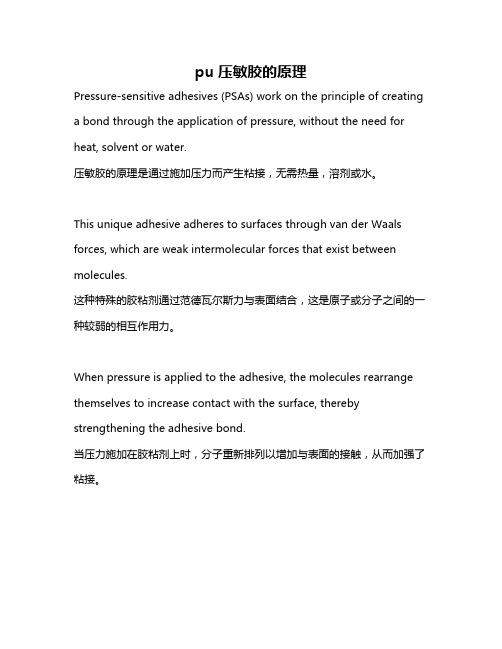
pu压敏胶的原理Pressure-sensitive adhesives (PSAs) work on the principle of creating a bond through the application of pressure, without the need for heat, solvent or water.压敏胶的原理是通过施加压力而产生粘接,无需热量,溶剂或水。
This unique adhesive adheres to surfaces through van der Waals forces, which are weak intermolecular forces that exist between molecules.这种特殊的胶粘剂通过范德瓦尔斯力与表面结合,这是原子或分子之间的一种较弱的相互作用力。
When pressure is applied to the adhesive, the molecules rearrange themselves to increase contact with the surface, thereby strengthening the adhesive bond.当压力施加在胶粘剂上时,分子重新排列以增加与表面的接触,从而加强了粘接。
The pressure-sensitive nature of this adhesive allows for immediate bond formation upon contact with a surface, making it a convenient and efficient bonding solution.这种胶粘剂的压敏特性使其在与表面接触时立即形成粘接,是一种便利和高效的粘接解决方案。
In addition to its adhesive properties, PSAs are often designed to be removable and repositionable, meaning they can be removed from a surface without leaving residue and then reapplied elsewhere.除了其粘合特性外,压敏胶通常设计成可拆卸和可重新定位的,这意味着它们可以从表面上移除而不留下残留物,然后再次应用在其他地方。
压敏胶作用原理与技术介绍

薄薄
TThhininAAddhheessivivee
有有限限度度的的接接触触 LLimimitieteddCCoonntatacct t
厚厚
TThhicickkAAddhheessivivee
最最大大接接触触面面积积 MMaaxximimuummCCoonntatacct t
粗糙的表面
化学溶剂的影响
粘接力
硬性胶 Firm
软性胶 Soft
驻留时间
初期与最终粘接力
初初期期粘粘接接力力 无无驻驻留留时时间间
IInnititiaiallAAddhheessioionn NNooDDwweellllTTimimee
最最终终粘粘接接力力 驻驻留留时时间间::
UUltltimimaatteeAAddhheessioionn 7722 小小时时//7700ººCC
胶粘剂选择
其他的使用条件
是否需要重复开闭 是否需要UL或其他认证 对颜色是否有要求 是否有或需要合适的涂胶设备 是否还有其他的特殊要求?
压敏胶带类型的选择小结
底材 耐温性 使用条件 终粘性 初粘性 耐久性 成本
– 软质聚氯乙烯 – 橡胶
挥发出的潮气
聚碳酸酯
粘接失败的原因?(其它原因)
养护时间 施工压力 施工环境 温度
表面污染
油脂, 指纹, 水, 油 和 注塑用的离型剂
– 阻碍胶与背材接合
尘埃, 石粉, 纤维持等
– 影响胶的粘性 – 减少有效的接触面积
表面能
粘接力是不同材料分子间的相互吸引作
PVA Polyvinyl Acetate 聚乙烯 Polyethylene 聚苯 Polystyrene 聚丙烯 Polypropylene 聚氟Teflon
3M压敏胶作用原理与技术介绍

3M压敏胶作用原理与技术介绍首先,让我们来了解一下3M压敏胶的作用原理。
3M压敏胶是一种粘合剂,它的特点是在正常条件下具有卓越的粘附性能,即使在轻微应力下也能起到粘合的效果。
这是因为3M压敏胶的分子结构中含有各种高分子链,这些链在胶黏剂干燥后形成的均匀胶层中排列紧密。
当胶黏剂与被粘合物接触时,这些高分子链能够与被粘结物表面形成千层结构,形成卓越的亲合力和表面能,从而使胶黏剂牢固地粘结在被粘结物上。
其次,3M压敏胶在技术方面具有一些特点。
首先,它具有较高的粘接力和剪切强度,能够承受较大的拉伸或剪切应力。
这使得3M压敏胶成为一种可靠和经济的粘合剂选择。
其次,3M压敏胶可以在各种温度下保持良好的粘附性能。
无论是在极寒的条件下,还是在高温环境中,3M压敏胶都能够保持其粘结性能不受影响。
此外,3M压敏胶也具有很好的耐老化和耐化学性能,能够长时间保持其粘性和稳定性。
在应用方面,3M压敏胶广泛应用于各行各业。
在工业制造领域,3M压敏胶通常用于粘合金属、塑料和橡胶等材料,用于制造汽车零部件、电子产品和工业设备。
由于3M压敏胶具有良好的耐化学性和耐温性能,可以在各种恶劣环境中使用。
例如,它可以用于粘合汽车的车身件、玻璃和汽车内饰件,因为它可以抵抗车内高温和紫外线的影响。
在电子设备领域,3M压敏胶通常用于粘合微电子元件、PCB板和电线连接器等。
由于其优异的粘接和电绝缘性能,它可以确保电子设备的稳定性和可靠性。
此外,在医疗设备和家居用品领域,3M压敏胶也得到了广泛应用。
它可以用于粘合医疗器械、贴合绷带和创可贴等,因为它对皮肤友好,同时还具有良好的透气性和防水性。
总之,3M压敏胶是一种具有卓越粘附性能的粘合剂,其作用原理是在分子层面上与被粘结物形成千层结构,从而产生稳定和可靠的粘合效果。
在技术方面,3M压敏胶具有高粘接力、广温性能、耐化学性和耐老化性能等特点。
在应用方面,它广泛应用于工业制造、电子设备、医疗设备和家居用品等领域,用于粘合各种材料和组件。
压敏胶作用原理与技术介绍解读
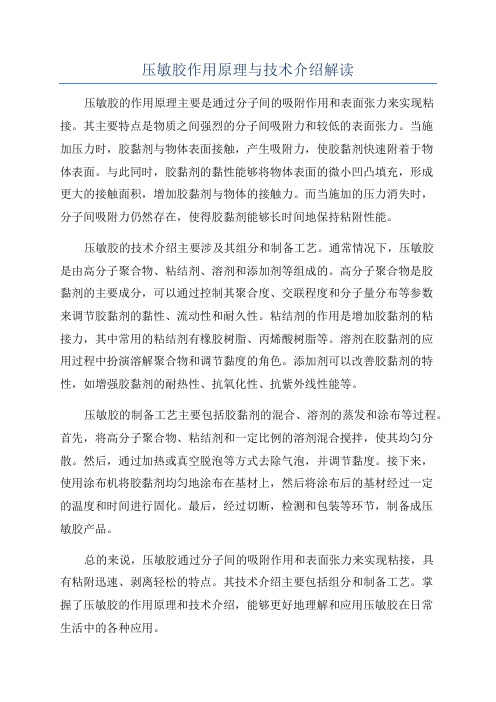
压敏胶作用原理与技术介绍解读压敏胶的作用原理主要是通过分子间的吸附作用和表面张力来实现粘接。
其主要特点是物质之间强烈的分子间吸附力和较低的表面张力。
当施加压力时,胶黏剂与物体表面接触,产生吸附力,使胶黏剂快速附着于物体表面。
与此同时,胶黏剂的黏性能够将物体表面的微小凹凸填充,形成更大的接触面积,增加胶黏剂与物体的接触力。
而当施加的压力消失时,分子间吸附力仍然存在,使得胶黏剂能够长时间地保持粘附性能。
压敏胶的技术介绍主要涉及其组分和制备工艺。
通常情况下,压敏胶是由高分子聚合物、粘结剂、溶剂和添加剂等组成的。
高分子聚合物是胶黏剂的主要成分,可以通过控制其聚合度、交联程度和分子量分布等参数来调节胶黏剂的黏性、流动性和耐久性。
粘结剂的作用是增加胶黏剂的粘接力,其中常用的粘结剂有橡胶树脂、丙烯酸树脂等。
溶剂在胶黏剂的应用过程中扮演溶解聚合物和调节黏度的角色。
添加剂可以改善胶黏剂的特性,如增强胶黏剂的耐热性、抗氧化性、抗紫外线性能等。
压敏胶的制备工艺主要包括胶黏剂的混合、溶剂的蒸发和涂布等过程。
首先,将高分子聚合物、粘结剂和一定比例的溶剂混合搅拌,使其均匀分散。
然后,通过加热或真空脱泡等方式去除气泡,并调节黏度。
接下来,使用涂布机将胶黏剂均匀地涂布在基材上,然后将涂布后的基材经过一定的温度和时间进行固化。
最后,经过切断,检测和包装等环节,制备成压敏胶产品。
总的来说,压敏胶通过分子间的吸附作用和表面张力来实现粘接,具有粘附迅速、剥离轻松的特点。
其技术介绍主要包括组分和制备工艺。
掌握了压敏胶的作用原理和技术介绍,能够更好地理解和应用压敏胶在日常生活中的各种应用。
压敏胶原理

* 硅橡胶 * 氟塑料
surface PE
表面清洁
• 针对不同的表面污染采用不同的清洁剂:
污染类型 指纹 水汽 油、脂 重度油污 脱模剂
清洁剂 异丙醇(IPA) 异丙醇(IPA) 庚烷(Heptane) 丁酮(MEK) 向制造商咨询
• 注意:对于塑料基材,进行合适的清洁非常重要!
3胶带与胶粘剂产品
3粘接技术
全球概况
成立于1902年
3M道琼斯工业股票指数 成份之一
《财富》“全球最受尊敬 的20家企业之一” 《商业周刊》“全球创新 企业20强” 3M公司连续入选 “道琼 斯永续指数”
全球机构:
有销售的国家............... 超过200家
设立子公司的国家.............. 65个 工厂............................... 139家
内聚力
Cohesion Properties
Maximum
Maximum
Adhesion Level
软性与硬性压敏胶
Soft and Firm Adhesives
硬性胶 Firm
软性胶 Soft
粘力
驻留时间 Dwell Time
粘接力和内聚力
粘接力Adhesion
存在两种表面之间的力量 Force between dissimilar sur本适中 可用于户外
耐高温, 260 度 耐低温 耐老化 优异的耐紫外 和耐溶剂性能 初粘性一般 成本高
压敏胶类型的选择
• 底材 • 耐温性 • 使用条件 • 终粘性 • 初粘性 • 耐久性 • 成本
粘接失败的原因?
• 压敏胶与底材不匹配
Water Drop Substrate
压敏胶作用原理与技术介绍
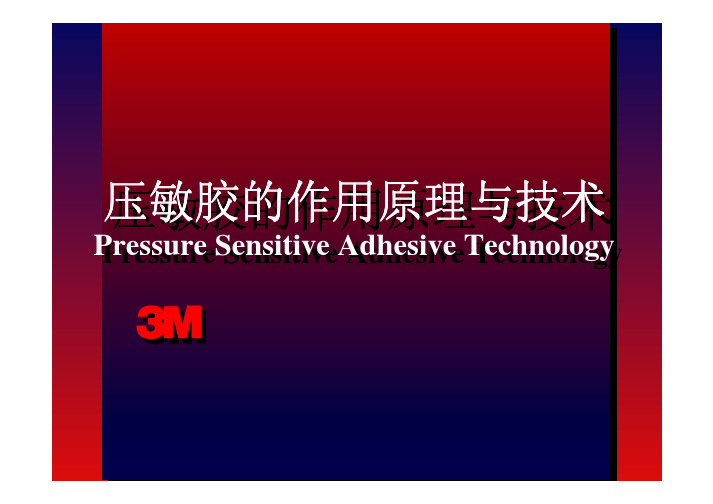
压敏胶的作用原理与技术Pressure Sensitive Adhesive Technology压敏胶的作用原理与技术Pressure Sensitive Adhesive Technology压敏胶的定义拥有持久的高粘度应用时只需用手或手指施压不需水, 溶剂或加热过程有牢靠的粘接力有足够的内聚力和弹性压敏胶带的好处不须涂布不须涂布,,混合等预处理步骤 胶量均匀 使用方便使用方便,,快捷 可以模切成各种形状持久的粘弹性可以避免脆化持久的粘弹性可以避免脆化,,断裂等现象表面能粘接力是不同材料分子间的相互吸引作用,材料的表面能决定了这种吸引力的大小大小。
表面能越高越高,,吸引力越大吸引力越大,,表面能越低越低,,吸引力越小吸引力越小。
高表面能High Surface Energy高表面能High Surface Energy PVA Polyvinyl Acetate 聚乙烯Polyethylene 聚苯Polystyrene 聚丙烯Polypropylene 聚氟Teflon低表面能Low Surface Energy低表面能Low Surface Energy 难以粘接粘接性Adhesion Properties内聚力特性Cohesion Properties软Soft硬Firm压敏胶Pressure SensitiveAdhesives粘性与剪切力低粘性材料(例如例如::水)–高流动性–不须施加压力–无剪力 高粘性材料(例如例如::油, 蜂蜜)–只需少许压力便可以流动–低剪力–无法持久承受荷重硬性胶Firm 软性胶Soft初粘力无驻留时间Initial Adhesion No Dwell Time初粘力无驻留时间Initial Adhesion No Dwell Time 终接力驻留时间:Ultimate Adhesion72 小时/ 25 ºC终接力驻留时间:Ultimate Adhesion 72 小时/ 25 ºC压敏胶的化学构成 橡胶类–天然胶–人造胶丙烯酸类–纯丙烯酸类–改良丙烯酸类有机硅类压敏胶的化学构成橡胶型Rubber橡胶型Rubber 初粘性好适合多种材质成本低耐温< 90 C 耐化学品差耐紫外差耐老化性能差适用于室内丙烯酸型Acrylic丙烯酸型Acrylic 耐久性能优异粘接多种材质耐高温, 可达230C 优异的耐紫外和化学品初粘性略低成本适中可用于户外有机硅型Silicone有机硅型Silicone 耐高温, 260 C 耐低温耐老化优异的耐紫外和耐溶剂性能初粘性一般成本高丙烯酸类Acrylic橡胶类Rubber 驻留时间基材:棉纸或聚酯等塑料基材:棉纸或聚酯等塑料压敏胶压敏胶压敏胶压敏胶两面涂有有机硅的隔离纸两面涂有有机硅的隔离纸卷状单层隔离纸胶膜卷状单层隔离纸胶膜双层隔离纸胶膜双层隔离纸胶膜基材的作用及其种类基材的功用–确保尺寸的稳定性–可模切–易操作•纸巾基材可撕断•薄膜类抗撕, 强度高•有贴附性(PVC,PE)–可使胶带较容易地移去–调节厚度–功能性(导电,屏蔽) 基材的种类–纸基–棉纸类–塑料薄膜类•PET 膜•UPVC 膜•PE膜•HDPE 膜•PP膜粘接失败的原因?压敏胶与底材不匹配表面平整度表面污染–脱模剂–尘埃增塑剂迁移–软质聚氯乙烯–橡胶挥发出的潮气聚碳酸酯粘接失败的原因?(其它原因) 养护时间施工压力施工环境温度针对不同的表面污染采用不同的清洁剂针对不同的表面污染采用不同的清洁剂::表面清洁污染类型清洁剂指纹异丙醇(IPA)水汽异丙醇(IPA)油、脂庚烷(Heptane)重度油污丁酮(MEK)脱模剂向制造商咨询注意注意::对于塑料基材对于塑料基材,,进行合适的清洁非常重要进行合适的清洁非常重要!!对表面进行打磨可以增加接触面积并锐化表面沟纹对表面进行打磨可以增加接触面积并锐化表面沟纹,,提高胶接强度表面打磨压敏胶带类型的选择小结底材耐温性使用条件终粘性初粘性耐久性成本剥离力Peel衡量粘接力剥离力Peel 衡量粘接力剪切力Shear衡量内聚力剪切力Shear 衡量内聚力LoadLoad TapeTape Test PanelTest Panel180Peel180Peel 90ºPeel90ºPeelRolldown Machine拉力测试仪拉力测试仪((剥离力剥离力,,动态剪切动态剪切))剥离力测试条件 环境条件环境条件::温度温度::23c 湿度湿度::55% 辊压条件辊压条件::辊重辊重::4.5磅辊速辊速::304.8mm/min (1个来回)背材背材::PET 膜或铝箔 板材板材::ASTM 标准钢板 测试条件测试条件::拉伸速度拉伸速度::304.8mm/min动态剪切测试条件 环境条件环境条件::温度温度::23c 湿度湿度::55% 板材板材::标准钢板或由客户提供测试条件测试条件::搭接面积搭接面积::0.5*1或1*1平方英寸静态剪切测试仪静态剪切测试条件 环境条件环境条件::温度温度::23c 湿度湿度::55% 辊压条件辊压条件::辊重辊重::4.5磅辊速辊速::304.8mm/min (1个来回)背材背材::PET 膜板材板材::标准钢板 测试条件测试条件::负重负重::250、500、1000克搭接面积搭接面积::0.5*1或1*1平方英寸Q&A。
压敏胶原理

压敏胶原理
压敏胶是一种具有特殊粘附性能的胶粘剂,它可以在受到外力作用时产生粘附性。
压敏胶的粘附性能是指在外力作用下,胶粘剂能够在不使用溶剂、水或热能的情况下,与被粘物表面产生持久的粘附性。
压敏胶的粘附性能是由其特殊的化学结构和物理性能所决定的。
首先,压敏胶的粘附性能与其分子结构有关。
一般来说,压敏胶的分子结构中含有大量的极性基团,这些基团可以与被粘物表面的分子发生相互作用,从而产生粘附力。
此外,压敏胶分子链的长度和交联程度也会影响其粘附性能,较长的分子链和适度的交联结构有利于增强压敏胶的粘附性能。
其次,压敏胶的粘附性能与其物理性能有关。
压敏胶通常具有较高的延展性和柔韧性,这使得它可以更好地适应被粘物表面的形状和不规则性,从而增强了其粘附性能。
此外,压敏胶的表面粗糙度和表面能也会影响其粘附性能,适当的表面粗糙度和表面能有利于增强压敏胶的粘附性能。
压敏胶的粘附性能是由其特殊的化学结构和物理性能共同决定的。
在实际应用中,我们可以通过调整压敏胶的分子结构和物理性能来改善其粘附性能,以满足不同应用场合的需要。
同时,我们也可以通过合理选择被粘物的表面处理方法,来提高压敏胶的粘附性能。
综上所述,压敏胶的粘附性能是由其分子结构和物理性能共同决定的。
了解压敏胶的粘附原理,有助于我们更好地应用压敏胶,并在实际生产中进行有效的质量控制。
希望本文对压敏胶的粘附原理有所帮助。
压敏胶作用原理与技术介绍
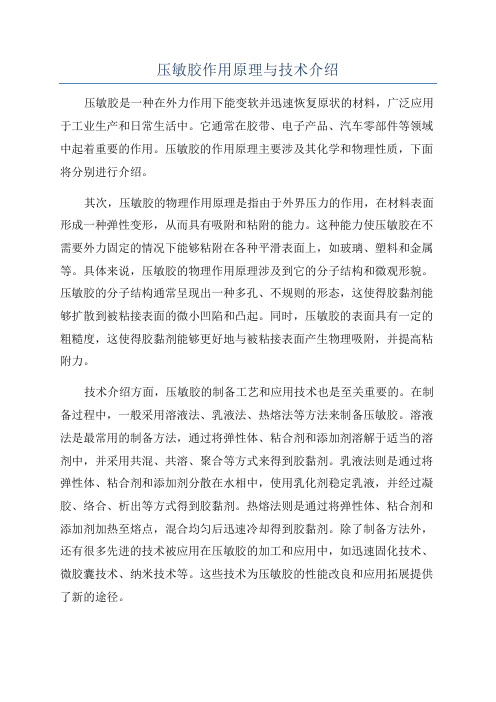
压敏胶作用原理与技术介绍压敏胶是一种在外力作用下能变软并迅速恢复原状的材料,广泛应用于工业生产和日常生活中。
它通常在胶带、电子产品、汽车零部件等领域中起着重要的作用。
压敏胶的作用原理主要涉及其化学和物理性质,下面将分别进行介绍。
其次,压敏胶的物理作用原理是指由于外界压力的作用,在材料表面形成一种弹性变形,从而具有吸附和粘附的能力。
这种能力使压敏胶在不需要外力固定的情况下能够粘附在各种平滑表面上,如玻璃、塑料和金属等。
具体来说,压敏胶的物理作用原理涉及到它的分子结构和微观形貌。
压敏胶的分子结构通常呈现出一种多孔、不规则的形态,这使得胶黏剂能够扩散到被粘接表面的微小凹陷和凸起。
同时,压敏胶的表面具有一定的粗糙度,这使得胶黏剂能够更好地与被粘接表面产生物理吸附,并提高粘附力。
技术介绍方面,压敏胶的制备工艺和应用技术也是至关重要的。
在制备过程中,一般采用溶液法、乳液法、热熔法等方法来制备压敏胶。
溶液法是最常用的制备方法,通过将弹性体、粘合剂和添加剂溶解于适当的溶剂中,并采用共混、共溶、聚合等方式来得到胶黏剂。
乳液法则是通过将弹性体、粘合剂和添加剂分散在水相中,使用乳化剂稳定乳液,并经过凝胶、络合、析出等方式得到胶黏剂。
热熔法则是通过将弹性体、粘合剂和添加剂加热至熔点,混合均匀后迅速冷却得到胶黏剂。
除了制备方法外,还有很多先进的技术被应用在压敏胶的加工和应用中,如迅速固化技术、微胶囊技术、纳米技术等。
这些技术为压敏胶的性能改良和应用拓展提供了新的途径。
综上所述,压敏胶的作用原理主要涉及其化学和物理性质。
通过切变可逆反应和弹性变形,压敏胶具有可粘连和分离的特性,并能粘附在各种表面上。
同时,压敏胶的制备工艺和应用技术也对其性能和应用具有重要影响。
随着科技的不断发展,人们对压敏胶的需求也在不断增加,相信在未来会有更多优化和创新的技术应用于压敏胶领域。
压敏胶作用原理与技术介绍
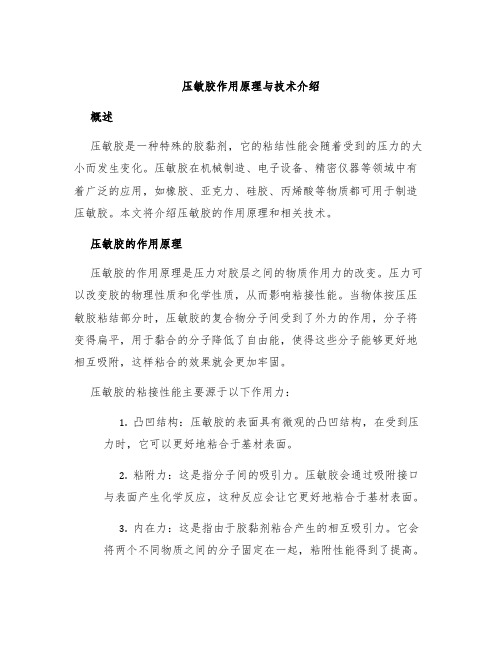
压敏胶作用原理与技术介绍概述压敏胶是一种特殊的胶黏剂,它的粘结性能会随着受到的压力的大小而发生变化。
压敏胶在机械制造、电子设备、精密仪器等领域中有着广泛的应用,如橡胶、亚克力、硅胶、丙烯酸等物质都可用于制造压敏胶。
本文将介绍压敏胶的作用原理和相关技术。
压敏胶的作用原理压敏胶的作用原理是压力对胶层之间的物质作用力的改变。
压力可以改变胶的物理性质和化学性质,从而影响粘接性能。
当物体按压压敏胶粘结部分时,压敏胶的复合物分子间受到了外力的作用,分子将变得扁平,用于黏合的分子降低了自由能,使得这些分子能够更好地相互吸附,这样粘合的效果就会更加牢固。
压敏胶的粘接性能主要源于以下作用力:1.凸凹结构:压敏胶的表面具有微观的凸凹结构,在受到压力时,它可以更好地粘合于基材表面。
2.粘附力:这是指分子间的吸引力。
压敏胶会通过吸附接口与表面产生化学反应,这种反应会让它更好地粘合于基材表面。
3.内在力:这是指由于胶黏剂粘合产生的相互吸引力。
它会将两个不同物质之间的分子固定在一起,粘附性能得到了提高。
4.机械膨胀力:当外在压力越来越大时,分子间距会缩小,这导致压敏胶增加粘合性能,从而使之成为压敏相位的一部分。
通过调整分子结构、粘附剂、起始剂以及添加剂等参数,可以优化压敏胶的作用原理。
压敏技术的应用压敏技术广泛应用于人们的日常生活,其中包括以下几个方面:1.靖脱带:靖脱带贴合脱落面时可以与胶黏剂相互作用,保证快速、可靠地粘合在平滑表面上。
2.包装胶带:包装胶带可以方便地密封包装盒、纸板、信封等物品,使之避免受到雨水、灰尘等外界物质的侵蚀。
3.电子产品:压敏胶可以用于制作触摸屏、线路板、LED背光、电池盖等电子产品,有很强的耐压性、耐水性和耐温性。
4.医疗产品:压敏胶可以用于制造医用绷带、医用敷料、吸收器等产品,还可以制作便携型血糖仪、医疗贴等。
5.交通运输:压敏胶可以用于制造车用散热片、发动机罩、挡泥板等产品,具有良好的抗氧化、耐油和高温耐受性。
压敏胶的粘结原理

压敏胶的粘结原理压敏胶又称压敏粘合剂,是一种具有压敏性质的胶粘剂,可在施加外力时发挥黏结作用,一旦外力消失,则胶粘剂即恢复到非粘性状态。
压敏胶广泛应用于各种领域,如标签、胶带、医疗用品、汽车制造等。
其独特的粘结原理使其具有诸多优点,如易于应用、持久的黏附性以及对多种材料的黏附性。
压敏胶的粘结原理主要受到两种基本作用力的影响:物理作用力和分子作用力。
首先是物理作用力,压敏胶基于物理作用力来实现黏结。
当施加外力时,压敏胶的结构会发生变化,使得其表面形成微小的凹凸结构,与物体表面形成紧密的结合。
这种机械锁定的方式使得压敏胶在施加外力时产生黏结效果,一旦外力消失,压敏胶又会回到原来的非粘性状态。
这种机械作用力是压敏胶实现黏结的重要因素之一。
其次,分子作用力也是影响压敏胶粘结的重要因素。
压敏胶的分子结构使其表现出诸如分子间力、静电吸引力等作用力。
这些作用力使得压敏胶在其分子水平上与物体表面形成紧密的相互作用,从而实现黏结效果。
这些分子作用力的存在使得压敏胶具有较强的黏结性能,并且能够适应不同材料的表面。
除了物理作用力和分子作用力外,压敏胶的粘结原理还与其物理和化学性质有关。
例如,压敏胶通常采用一种弹性良好的高分子物质作为基质,使得其具有良好的可塑性和可形变性,在施加外力后能够形成紧密的黏结。
此外,压敏胶的化学性质也会影响其黏结效果,如化学反应能力、氧化还原性等。
这些物理和化学性质共同作用,使得压敏胶能够实现在施加外力时产生黏结,在外力消失时再恢复非粘性状态的特殊黏结效果。
压敏胶的粘结原理还与其在制备过程中的添加剂及配方有关。
在生产压敏胶时,生产厂家通常会在基质中添加各种助剂,如黏度调节剂、固化剂、增稠剂等,以调整压敏胶的性能。
这些添加剂能够对压敏胶的黏结效果产生影响,通过调整配方中添加剂的种类和比例,可以改变压敏胶的黏结性能,使得其能够更好地适应各种不同的应用场景。
总的来说,压敏胶的粘结原理是基于物理作用力和分子作用力的相互作用,使得其在施加外力时能够形成黏结,外力消失时又能够恢复非粘性状态。
压敏胶作用原理与技术介绍解读

Pressure Sensitive Adhesive Technology压敏胶的作用原理与技术压敏胶的定义拥有持久的高粘度应用时只需用手或手指施压不需水, 溶剂或加热过程有牢靠的粘接力有足够的内聚力和弹性压敏胶带的好处不须涂布,不须涂布,混合等预处理步骤胶量均匀使用方便,使用方便,快捷可以模切成各种形状持久的粘弹性可以避免脆化,持久的粘弹性可以避免脆化象,断裂等现表面能作用,材料的表面能决定了这种吸引力的大小。
大小。
表面能越高,越高,吸引力越大,吸引力越大,表面能越低,越低,吸引力越小。
吸引力越小。
粘接力是不同材料分子间的粘性与剪切力低粘性材料(例如:例如:水)–高流动性–不须施加压力–无剪力高粘性材料(例如:例如:油, 蜂蜜)–只需少许压力便可以流动–低剪力–无法持久承受荷重压敏胶的化学构成橡胶类–天然胶–人造胶丙烯酸类–纯丙烯酸类–改良丙烯酸类有机硅类压敏胶的化学构成橡胶型Rubber橡胶型丙烯酸型有机硅型基材的作用及其种类基材的功用–确保尺寸的稳定性–可模切–易操作•纸巾基材可撕断•薄膜类抗撕, 强度高•有贴附性(PVC,PE)–可使胶带较容易地移去–调节厚度–功能性(导电,屏蔽)基材的种类–纸基–棉纸类–塑料薄膜类•PET 膜•UPVC 膜•PE膜•HDPE 膜•PP膜粘接失败的原因?压敏胶与底材不匹配表面平整度表面污染–脱模剂–尘埃增塑剂迁移–软质聚氯乙烯–橡胶挥发出的潮气聚碳酸酯粘接失败的原因?(其它原因) 养护时间施工压力施工环境温度表面清洁针对不同的表面污染采用不同的清洁剂:针对不同的表面污染采用不同的清洁剂:指纹异丙醇(IPA)水汽异丙醇(IPA)油、脂庚烷(Heptane)重度油污丁酮(MEK)脱模剂向制造商咨询注意:注意:对于塑料基材,对于塑料基材,进行合适的清洁非常重要!进行合适的清洁非常重要!表面打磨对表面进行打磨可以增加接触面积并锐化表面沟纹,对表面进行打磨可以增加接触面积并锐化表面沟纹,提高胶接强度压敏胶带类型的选择小结底材耐温性使用条件终粘性初粘性耐久性成本RolldownMachine拉力测试仪(拉力测试仪(剥离力,剥离力,动态剪切)动态剪切)剥离力测试条件环境条件:环境条件:温度:温度:23c 湿度:湿度:55%辊压条件:辊压条件:辊重:辊重:4.5磅辊速:辊速:304.8mm/min (1个来回)背材:背材:PET膜或铝箔板材:板材:ASTM标准钢板测试条件:测试条件:拉伸速度:拉伸速度:304.8mm/min动态剪切测试条件环境条件:环境条件:温度:温度:23c 湿度:湿度:55%板材:板材:标准钢板或由客户提供测试条件:测试条件:搭接面积:搭接面积:0.5*1或1*1平方英寸静态剪切测试仪静态剪切测试条件环境条件:环境条件:温度:温度:23c 湿度:湿度:55%辊压条件:辊压条件:辊重:辊重:4.5磅辊速:辊速:304.8mm/min (1个来回)背材:背材:PET膜板材:板材:标准钢板测试条件:测试条件:负重:负重:250、500、1000克搭接面积:搭接面积:0.5*1或1*1平方英寸Q&A。
丙烯酸酯压敏胶固化原理

丙烯酸酯压敏胶固化原理丙烯酸酯压敏胶是一种常用的胶粘剂,其固化原理是通过光引发剂的作用,使得丙烯酸酯分子中的双键发生聚合反应,从而形成交联网络结构。
本文将从丙烯酸酯压敏胶的基本概念、固化原理及应用领域等方面进行探讨。
一、丙烯酸酯压敏胶的基本概念丙烯酸酯压敏胶是一种以丙烯酸酯单体为主要成分的胶粘剂,其特点是具有良好的粘接性能和可撕性。
丙烯酸酯单体是一种具有活性双键的化合物,可以通过光引发剂的作用,进行聚合反应,形成高分子聚合物结构。
二、丙烯酸酯压敏胶的固化原理丙烯酸酯压敏胶的固化是通过光引发剂的作用,引发丙烯酸酯单体中的双键聚合反应,从而形成交联网络结构。
具体的固化过程可以分为以下几个步骤:1. 光引发剂吸收光能:丙烯酸酯压敏胶中加入的光引发剂能够吸收特定波长的光能,将其转化为化学能。
2. 双键聚合反应:光引发剂吸收光能后,会引发丙烯酸酯单体中的双键发生聚合反应。
在聚合反应中,丙烯酸酯单体中的双键开启,与周围的丙烯酸酯分子发生反应,形成链状或交联结构。
3. 交联网络形成:随着聚合反应的进行,丙烯酸酯单体之间的双键不断聚合,最终形成交联网络结构。
这种交联网络结构赋予了丙烯酸酯压敏胶良好的粘接性能和可撕性。
三、丙烯酸酯压敏胶的应用领域丙烯酸酯压敏胶具有广泛的应用领域,主要包括以下几个方面:1. 印刷和包装行业:丙烯酸酯压敏胶可以作为标签、胶带等粘合剂在印刷和包装行业中使用。
其优良的粘接性能和可撕性使得标签和胶带可以牢固粘贴在不同的表面上,并且在需要时可以方便地撕下。
2. 医疗领域:丙烯酸酯压敏胶在医疗领域中被广泛应用于医用胶带、敷料等产品中。
其具有较强的粘接性能和生物相容性,可以有效固定敷料,保护伤口。
3. 电子行业:丙烯酸酯压敏胶在电子行业中被用作电子元件的粘合剂。
其良好的粘接性能可以保证电子元件与基板之间的可靠连接,提高产品的可靠性和稳定性。
4. 汽车行业:丙烯酸酯压敏胶在汽车行业中主要用于汽车内饰件的粘接。
压敏胶与压力的关系
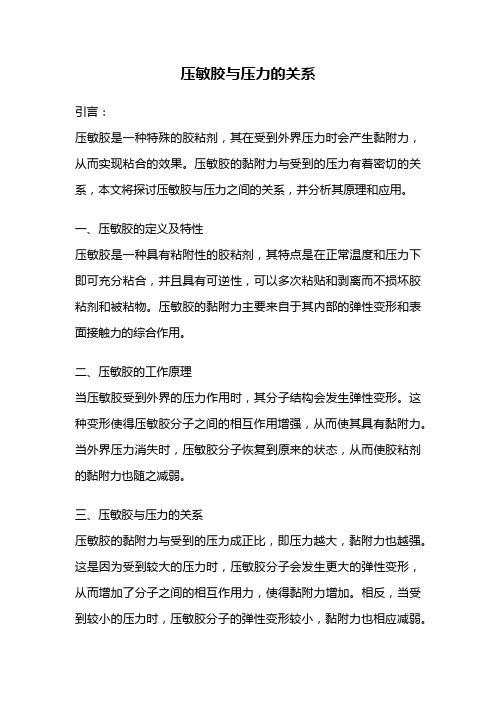
压敏胶与压力的关系引言:压敏胶是一种特殊的胶粘剂,其在受到外界压力时会产生黏附力,从而实现粘合的效果。
压敏胶的黏附力与受到的压力有着密切的关系,本文将探讨压敏胶与压力之间的关系,并分析其原理和应用。
一、压敏胶的定义及特性压敏胶是一种具有粘附性的胶粘剂,其特点是在正常温度和压力下即可充分粘合,并且具有可逆性,可以多次粘贴和剥离而不损坏胶粘剂和被粘物。
压敏胶的黏附力主要来自于其内部的弹性变形和表面接触力的综合作用。
二、压敏胶的工作原理当压敏胶受到外界的压力作用时,其分子结构会发生弹性变形。
这种变形使得压敏胶分子之间的相互作用增强,从而使其具有黏附力。
当外界压力消失时,压敏胶分子恢复到原来的状态,从而使胶粘剂的黏附力也随之减弱。
三、压敏胶与压力的关系压敏胶的黏附力与受到的压力成正比,即压力越大,黏附力也越强。
这是因为受到较大的压力时,压敏胶分子会发生更大的弹性变形,从而增加了分子之间的相互作用力,使得黏附力增加。
相反,当受到较小的压力时,压敏胶分子的弹性变形较小,黏附力也相应减弱。
四、压敏胶的应用领域由于压敏胶与压力的关系,使得其在许多领域得到广泛应用。
以下列举几个常见的应用领域:1. 贴纸和标签:压敏胶被广泛应用于贴纸和标签的制作中,通过受到压力,使得贴纸和标签能够牢固地黏附在物体表面上。
2. 包装材料:压敏胶也被广泛应用于包装材料中,例如胶带和封箱胶带,通过压力将包装材料黏合在一起,起到封装和固定的作用。
3. 医疗领域:在医疗领域,压敏胶被用于制作医用胶布和医用敷料,通过压力将胶布和敷料固定在伤口上。
4. 电子产品:压敏胶也被应用于电子产品中,例如手机和平板电脑的触摸屏,通过压力来感应用户的操作。
结论:压敏胶与压力之间存在着密切的关系,压力的大小直接影响到压敏胶的黏附力。
压敏胶的工作原理是通过分子的弹性变形来实现黏附力的产生和消失。
压敏胶的应用广泛,涵盖了贴纸、包装材料、医疗用品和电子产品等众多领域。
压敏胶的原理

压敏胶的原理压敏胶是一种特殊的粘合剂,它的粘合性能受到外力作用而变化。
在正常情况下,压敏胶表现出较低的粘度,但当受到外力压缩时,它会迅速增加粘度,从而实现对物体的粘合。
那么,压敏胶的原理是什么呢?首先,我们来了解一下压敏胶的基本成分。
压敏胶通常由高分子材料制成,其中包含了大量的粘合剂和添加剂。
这些成分使得压敏胶具有较好的粘附性和可塑性,从而能够适应不同形状和表面的物体。
其次,压敏胶的原理与其微观结构有关。
在压敏胶的微观结构中,有许多微小的颗粒或链状结构,它们之间存在着一定的间隙。
这种结构使得压敏胶在受到外力时,这些颗粒或链状结构会发生变形,从而增加了粘度,实现了对物体的粘合。
同时,当外力消失时,这些颗粒或链状结构又会恢复原状,使得压敏胶再次表现出较低的粘度。
另外,压敏胶的原理还与其分子间的相互作用有关。
在正常情况下,压敏胶分子间的相互作用较弱,导致其粘度较低。
但是当受到外力作用时,这种相互作用会得到加强,从而使得压敏胶的粘度迅速增加。
这种分子间的相互作用是压敏胶实现粘合的重要原理之一。
总的来说,压敏胶的原理是通过外力作用下,其微观结构和分子间相互作用的变化,使得其粘度迅速增加,从而实现对物体的粘合。
这种特殊的粘合原理使得压敏胶在许多领域得到了广泛的应用,如标签、胶带、医用敷料等。
压敏胶的原理不仅在实际应用中具有重要意义,而且也为我们理解材料科学提供了有益的参考。
通过对压敏胶的原理进行深入了解,我们可以更好地应用和改进这一材料,为各种领域的实际应用提供更好的解决方案。
希望本文能够帮助大家更好地理解压敏胶的原理,并在实际应用中发挥更大的作用。
丙烯酸酯压敏胶固化原理
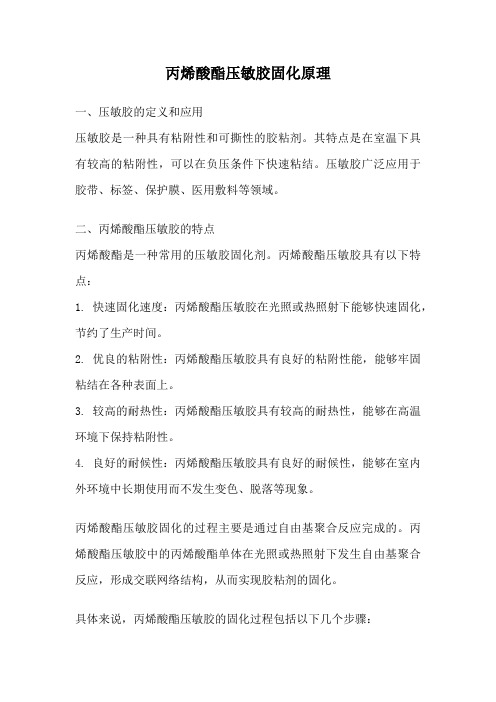
丙烯酸酯压敏胶固化原理一、压敏胶的定义和应用压敏胶是一种具有粘附性和可撕性的胶粘剂。
其特点是在室温下具有较高的粘附性,可以在负压条件下快速粘结。
压敏胶广泛应用于胶带、标签、保护膜、医用敷料等领域。
二、丙烯酸酯压敏胶的特点丙烯酸酯是一种常用的压敏胶固化剂。
丙烯酸酯压敏胶具有以下特点:1. 快速固化速度:丙烯酸酯压敏胶在光照或热照射下能够快速固化,节约了生产时间。
2. 优良的粘附性:丙烯酸酯压敏胶具有良好的粘附性能,能够牢固粘结在各种表面上。
3. 较高的耐热性:丙烯酸酯压敏胶具有较高的耐热性,能够在高温环境下保持粘附性。
4. 良好的耐候性:丙烯酸酯压敏胶具有良好的耐候性,能够在室内外环境中长期使用而不发生变色、脱落等现象。
丙烯酸酯压敏胶固化的过程主要是通过自由基聚合反应完成的。
丙烯酸酯压敏胶中的丙烯酸酯单体在光照或热照射下发生自由基聚合反应,形成交联网络结构,从而实现胶粘剂的固化。
具体来说,丙烯酸酯压敏胶的固化过程包括以下几个步骤:1. 引发剂的活化:在光照或热照射下,引发剂吸收能量,产生活化的自由基。
2. 自由基聚合反应:活化的自由基与丙烯酸酯单体发生反应,引发聚合反应。
丙烯酸酯单体中的双键开裂,自由基与其他单体发生反应,逐渐形成聚合物链。
3. 交联网络形成:聚合物链之间通过共价键连接,形成交联网络结构。
交联网络的形成使得胶粘剂具有了一定的机械强度和粘附性。
4. 固化过程的控制:固化过程中需要控制引发剂的添加量、光照或热照射的时间和强度,以及温度等条件,以确保胶粘剂能够达到理想的固化效果。
四、丙烯酸酯压敏胶固化的影响因素丙烯酸酯压敏胶固化的效果受到多种因素的影响,包括光照或热照射的强度和时间、温度、引发剂的种类和添加量等。
其中,光照或热照射是丙烯酸酯压敏胶固化的关键因素之一,不同光源或热源的强度和波长会对固化效果产生影响。
温度也是影响固化速度和效果的重要因素,适宜的固化温度可以提高胶粘剂的粘附性和耐热性。
3M_压敏胶的作用原理与技术
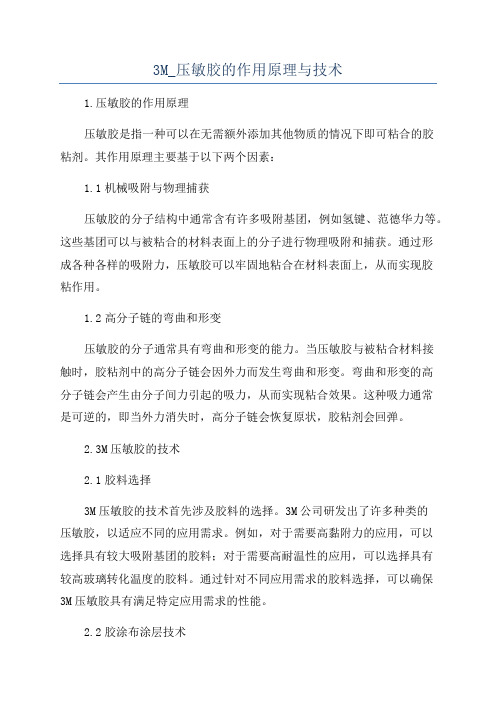
3M_压敏胶的作用原理与技术1.压敏胶的作用原理压敏胶是指一种可以在无需额外添加其他物质的情况下即可粘合的胶粘剂。
其作用原理主要基于以下两个因素:1.1机械吸附与物理捕获压敏胶的分子结构中通常含有许多吸附基团,例如氢键、范德华力等。
这些基团可以与被粘合的材料表面上的分子进行物理吸附和捕获。
通过形成各种各样的吸附力,压敏胶可以牢固地粘合在材料表面上,从而实现胶粘作用。
1.2高分子链的弯曲和形变压敏胶的分子通常具有弯曲和形变的能力。
当压敏胶与被粘合材料接触时,胶粘剂中的高分子链会因外力而发生弯曲和形变。
弯曲和形变的高分子链会产生由分子间力引起的吸力,从而实现粘合效果。
这种吸力通常是可逆的,即当外力消失时,高分子链会恢复原状,胶粘剂会回弹。
2.3M压敏胶的技术2.1胶料选择3M压敏胶的技术首先涉及胶料的选择。
3M公司研发出了许多种类的压敏胶,以适应不同的应用需求。
例如,对于需要高黏附力的应用,可以选择具有较大吸附基团的胶料;对于需要高耐温性的应用,可以选择具有较高玻璃转化温度的胶料。
通过针对不同应用需求的胶料选择,可以确保3M压敏胶具有满足特定应用需求的性能。
2.2胶涂布涂层技术为了在应用中实现压敏胶的粘附效果,胶料需要被涂覆在胶带、贴片等基材上。
3M使用先进的涂布技术来实现胶涂布涂层过程。
该技术基于高精度的涂覆装备和精密的流体控制,可以将胶料均匀地涂布在基材上,并控制胶料的厚度和质量,从而确保3M压敏胶的性能稳定性。
2.3高温粘合技术对于一些特殊应用,需要在高温条件下进行粘合。
为了实现高温胶粘,3M开发了一系列高温胶粘剂。
这些胶粘剂具有较高的耐温性和耐化学品性,可以在高温环境下保持稳定的粘附力。
3M的高温胶粘技术包括胶料的选择、粘合剂的设计和优化等,以确保在高温条件下的胶粘性能。
总结3M压敏胶的作用原理基于机械吸附与物理捕获以及高分子链的弯曲和形变。
在技术方面,胶料的选择、胶涂布涂层技术和高温粘合技术是保证3M压敏胶性能的关键因素。
3M压敏胶的作用原理与技术
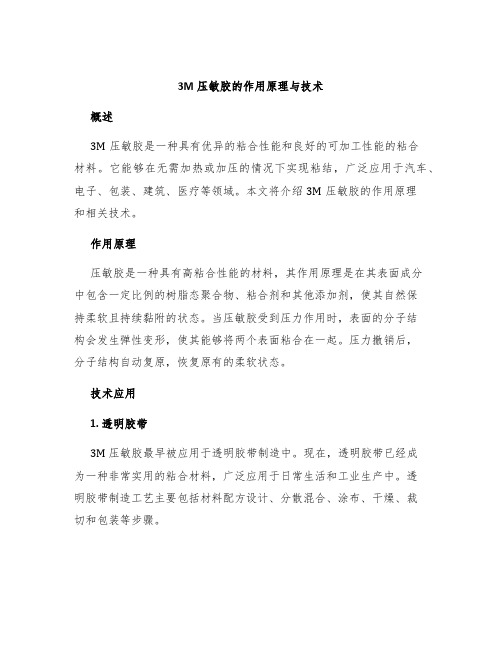
3M压敏胶的作用原理与技术概述3M压敏胶是一种具有优异的粘合性能和良好的可加工性能的粘合材料。
它能够在无需加热或加压的情况下实现粘结,广泛应用于汽车、电子、包装、建筑、医疗等领域。
本文将介绍3M压敏胶的作用原理和相关技术。
作用原理压敏胶是一种具有高粘合性能的材料,其作用原理是在其表面成分中包含一定比例的树脂态聚合物、粘合剂和其他添加剂,使其自然保持柔软且持续黏附的状态。
当压敏胶受到压力作用时,表面的分子结构会发生弹性变形,使其能够将两个表面粘合在一起。
压力撤销后,分子结构自动复原,恢复原有的柔软状态。
技术应用1. 透明胶带3M 压敏胶最早被应用于透明胶带制造中。
现在,透明胶带已经成为一种非常实用的粘合材料,广泛应用于日常生活和工业生产中。
透明胶带制造工艺主要包括材料配方设计、分散混合、涂布、干燥、裁切和包装等步骤。
2. 贴膜3M压敏胶制成的贴膜已成为许多移动设备、平板电脑和电子设备的重要组成部分。
现在,贴膜已逐渐发展成为一种重要的保护措施,可以在减少损耗的同时延长产品的使用寿命。
3. 汽车贴膜3M压敏胶制成的汽车贴膜可以在保护汽车表面的同时提高汽车的外观美感。
这种贴膜具有耐候性强、抗刮伤、耐腐蚀、耐化学性等特点。
汽车贴膜制造工艺主要包括贴膜材料的拼接、材料层的粘合、工艺表面涂覆等3个步骤。
4. 包装和标签3M压敏胶广泛应用于包装和标签制造中,可用于胶带、标签纸、便签、木匾和其他材料的黏合。
压敏胶的持久性和卓越的黏附力使其成为一种理想的工业材料。
总结本文简述了3M压敏胶的作用原理和相关应用技术。
3M压敏胶因具有高粘附性、自身柔韧性好和持续黏附性等优良特性,在灵活性和承受压力的情况下都能完美粘合,应用广泛。
- 1、下载文档前请自行甄别文档内容的完整性,平台不提供额外的编辑、内容补充、找答案等附加服务。
- 2、"仅部分预览"的文档,不可在线预览部分如存在完整性等问题,可反馈申请退款(可完整预览的文档不适用该条件!)。
- 3、如文档侵犯您的权益,请联系客服反馈,我们会尽快为您处理(人工客服工作时间:9:00-18:30)。
粘黏力 Adhesion
剪力 Shear
衡量 measures
内聚力 Cohesion
剪力
Shear Strength
Shear measures Cohesion - the internal
黏性
Viscous
黏弹性
Visco-elastic
弹性
Elastic
固体状
Solid
软
Soft
不乾胶
Pressure Sensitive Adhesives
韧
Firm
Maximum
粘黏 性
Adhesion Properties
Maximum
内聚力特性
Cohesion Properties
不 乾 胶 的 运 作 原理
容易黏接
Easy-to-adhere
低表面能 Low Surface Energy 难以黏接
Hard-to-adhere
金属Metals 聚碳Polycarbonate 聚酯Polyester 聚氯 乙烯PVC 聚氨Polyurethane 丙烯酸 Acrylic
Polyvinyl Acetate 聚乙烯 Polyethylene 聚苯 Polystyrene 聚丙烯 Polypropylene 聚氟Teflon
表面结构 Textured Surface 表面污染 Surface Contamination
– 离型剂 Mold Release, 尘埃 Dust Particles
增塑剂的移行 Plasticiser Migration
– 软质聚氯乙烯 Flexible PVC, 橡胶 Rubber
残留水份 Outgassing of Moisture
不乾胶的定义
Definition of PSA
拥有持久的高黏度
Aggressively and permanently tacky
应用时只需用手或手指施压
Adheres with finger or hand pressure
不需水, 溶剂或加热过程
Requires no activation by water, solvent or heat
Rubber
Acrylic (Tackified)
Acrylic (Nontackified)
Silicone
Advantages In door Effective “WETTING” properties High initial bond strength Good adhesion to various substrates Low cost In door & Excellent durability Out door Broad performance temperature range (-40 to 350 F) Excellent chemical & UV resistance In door & Significantly improved Out door “WETTING” properties Excellent bond to LSE plastics Good aging characteristics Fills gap between Acrylic and Rubber adhesives In door & Broad temperature Out door performance (-100 to 500 F) Excellent Durability
尘埃, 石粉, 纤维持等
Dust, Talc, Fiber, Particle Contamination
– 影响胶的黏性
Affects tackiness of adhesive
– 减少有效的接触面积
Reduce contact surface area
剥离力与剪力的测试
Peel vs Shear Test 剥离力 Peel
– 较低的初期粘黏力
Low initial bond strength
– 须较长的驻留时间
Requires longer dwell time
软性不乾胶 Soft Adhesive
– 良好的初期接触面积
Good immediate contact
– 较高的初期粘黏力
High initial bond strength
Can be die cut into specific shapes
持久的黏弹性可以避免脆化,断裂等现象
Stays viscoelastic which eliminates brittle fracture possible with epoxies, hot melts and cyanoacrylates
表 面 结 构与不乾胶的厚薄度
Surface Texture
薄
Thin Adhesive
厚
Thick Adhesive
有限度的接触
Limited Contact
最大接触面积
Maximum Contact
粗糙的表面
Textured Surface
不乾胶的化学构成
Pressure Sensitive Adhesive
初期粘黏力 无驻留时间
Initial Adhesion No Dwell Time
最终粘黏力 驻留时间:
Ultimate Adhesion 72 小 时/ 70 癈
软性与韧性的不乾胶
Soft and Firm Adhesives
韧性不乾胶 Firm Adhesive
– 较小的初期接触面积
Less immediate contact
非黏性材料 Non-viscous Materials (e.g. cured adhesives 作用 后的粘黏剂) – 无流动性 No flow characteristics – 无黏性 Not sticky – 有极高的剪力 Maximum shear strength
黏性和黏弹性
Viscosity and Visco-elasticity
时 间 Time
– 胶需要时间流动For adhesive to flow
温 度Temperature
– 高温可以减低胶的黏性 Decrease
adhesive viscosity
– 促进胶的流动性
Accelerates adhesive flow
– 促进胶的 Improve wetting
无臭,无味和溶剂 Less odor during use
粘黏力和内聚力
Adhesion and Cohesion
粘黏力Adhesion
存在两种表面之间的力量 Force between dissimilar surfaces
Substrate Adhesive Substrate
内聚力Cohesion
黏性与剪力
Viscosity and Shear Strength
黏弹性材料 Visco-elastic Materials
(e.g. Pressure Sensitive Adhesive 不乾胶)
– 使用时须施加压力 Require considerable rubdown pressure – 需驻留时间发挥效能 Require dwell time – 有优良的剪力 Well balanced shear properties
压 力Pressure
– 促进胶的流动性
Accelerates adhesive flow
压力
– 促进胶的
Improves surface wetting
– 避免汽泡的产生
Eliminates trapped air
表面能
Surface Energy
高表面能 High Surface Energy
高黏性材料 Higher Viscous Materials (e.g. Oil, Honey 油, 蜂蜜) – 只需少许压力便可以流动 Require moderate pressure to flow – 低剪力 Little shear strength – 无法持久承受荷重 Fail under continuous shear load
各种不干胶 Types of PSAs
Disadvantages Limited temperature performance (-20 to 200 F) Poorer durability Poorer chemical and U.V. resistance Limited “WETTING” characteristics Lower initial bond strength Limited to HSE materials Limited chemical and U.V. resistance Limited temperature performance (-40 to 250 F) High cost
Ready to use, no mixing or brushing is required
一贯性的胶量 Consistent amount of adhesive 使用上方便,快捷
Less messy than super glue and contact cement
可以模切成各种形状
How PSA Bonds ?
不乾胶 具有流动 性, 能 与 背 材 紧 密 接合 Adhesive must FLOW to CONTACT substrate 不乾胶与背材间的相互 作用 Adhesive - Substrate INTERACTION
